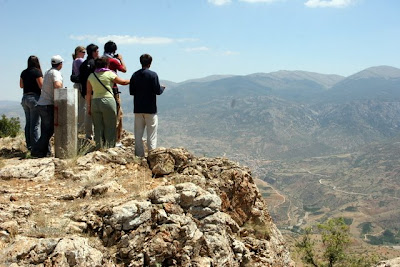We woke up this morning to Yasimin coming in to our rooms and saying cheerily “Gun eydun!” which means “good morning!” We rolled out of our very comfortable pallets and out to the big main room for an absolutely delicious breakfast of fried fresh-caught fish, cucumbers, tomatoes, cheese that they made themselves, walnuts from their orchard, and honey from their bees. And of course their staple, that flatbread and Turkish tea. An interesting thing about the flatbread – one day the women in the village all make huge amounts of the flatbread together that will last each family a very long time. At any rate, it was absolutely delicious with some of their walnuts and honey on it.
After breakfast, we headed to their orchard by the river to help them pick their peaches. Before puiling into the van, Yasimin noticed Amanda’s sunburned neck and tied one of her headscarves on Amanda to protect her neck from the sun. Yekta, Emily, and I followed suit in an attempt to protect our necks from getting sunburned in the first place.
On our van ride down the mountain, Hasan provided us with some entertainment with his enthusiastic singing. When we got there, Yasimin gave us a tour of the orchard which included peaches, cherries, walnuts, grapes, and probably a lot of other fruit that I’m forgetting. We also saw their bees, and some serious bee drama went on and Hasan let us watch – the queen bee from one hive tried to move to another, taking her faction of worker bees with her. It was very exciting, and Hasan shook them off the tree limb that they were on into his man-made honeycomb to transport them to one of his empty hives. I got a little nervous about a bee flying down my throat or nose, so I adjusted my headscarf.
the beehives
my headscarf keeping the bees out
Afterwards, Hasan and Emine left us with Yasimin to sort out and pack the peaches into crates instead of picking them, since we didn’t know how to pick correctly like they did.
Yekta, Amanda, and Emily at the orchard
carrying peaches
Emine and Yasmin
We sorted and packed for a few hours, with Yasimin being far quicker and better at it than we were, and then it was time for lunch. They set up a mini grill, and lit it with the wrappings of sugar cubes – ingenious kindling. We had yet another delicious feast of watermelon, cucumbers, tomatoes, grilled chicken, fried squash, and pasta in a yogurt sauce.
Then Muammer and the rest of the Burch gang (minus the profs, because Sarah was busy writing a children’s book about Turkey for National Geographic) came to pick us up and take us to the river to swim. 
Then the truly dangerous part of our adventure began – we attempted to climb up to the waterfall that was feeding the river. 
Hasan and Emine were in another town selling the peaches that we had helped them pack, so it was just Yasmin and us for dinner. I helped with dinner by cooking these little pancake things that were absolutely delicious, if I do say so myself (Yasmin made the batter, I just flipped them). After yet another delicious dinner, Yasmin showed us a bunch of pictures that she had received over the years from all the tourists that had come to stay with them. It was amazing to me that this is how she saw the world – through other people’s pictures of their travels. Without access to a library or the Internet (although she did have TV), these pictures were her only way to see things like London and the US. After that, she showed us her dowry, which she and her mom had been working on since she was about 12. 
When we were finally almost ready for bed, Hasan and Emine came home and insisted on having another feast of fruit with us (we had just brushed our teeth). Then it was time for bed in preparation for leaving the next day.

















































